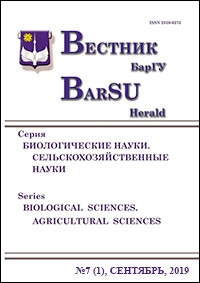BEETLES (INSECTA: COLEOPTERA) INHABITINGTHE FRUITING BODIES OF XYLOTROPHIC FUNGI IN THE NATIONAL PARK“BELOVEZHSKAYA PUSHCHA”
Keywords:
Beetles; mycetophagus; fruiting bodies; xylotrophic fungi; Belovezhskaya Pushcha; ColeopteraAbstract
The paper contains results of the study of fauna and ecology of beetles, which inhabit the fruiting bodies of
xylotrophic fungi in the National Park “Belovezhskaya Pushcha”.
On the territory of the National Park “Belovezhskaya Pushcha” beetles are connected in their development with
the fruiting bodies of 38 species of xylotrophic fungi, which belong to 7 orders. Most of xylotrophic fungi (20 species)
inhabited by beetles belong to Polyporales order. The species composition of beetles, which inhabit the fruiting bodies
of xylotrophic fungi in the Belarusian part of the National Park “Belovezhskaya Pushcha” has been revealed. It
contains 128 species belonging to 47 genera and 16 families. Representatives of Ciidae and Staphylinidae dominate
among beetles, which inhabit the fruiting bodies of xylotrophic fungi. They are represented by 29 and 24 species
respectively. The species under consideration constitute 14.41 % of the total number of the xylophilous beetles of the
Belarusian part of the National Park “Belovezhskaya Pushcha” and 6.09 % of the whole coleopterofauna of the
National Park “Belovezhskaya Pushcha”. The list of beetles, which inhabit the fruiting bodies of xylotrophic fungi in
the National Park “Belovezhskaya Pushcha” and are protected in European countries, includes 20 species belonging to
5 families. The maximum number among beetles species (114) are connected in their development with the fruiting
bodies of Polyporales fungi. It is explained by maximum taxonomic diversity of this order.
Among all xylotrophic fungi of the National Park, Fomes fomentarius is inhabited by the largest number of
species, which can develop only in the fruiting bodies of this fungus.
Table 2. Ref.: 7 titles.
Downloads
Published
Issue
Section
License
Copyright (c) 2023 Вестник БарГУ Серия "Биологические науки. Сельскохозяйственные науки"
Это произведение доступно по лицензии Creative Commons «Attribution-NonCommercial» («Атрибуция — Некоммерческое использование») 4.0 Всемирная.
Авторы сохраняют за собой право заключать определенные договорные соглашения, касающиеся неисключительного распространения опубликованной версии работы (например, размещать ее в институциональном репозитории, публикация в книге) со ссылкой на ее первоначальную публикацию в этом журнале.





